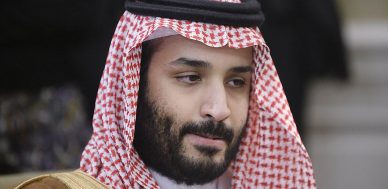Precursor to War? Saudi Arabia Releases Propaganda Video of “Liberation” of Tehran
After taking steps to reduce the chance of any opposition to his ambitious plans, Prince Muhammad bin Salman (MbS to his friends) continues to frame the power of Saudi Arabia as the “solution” to Iran’s growing influence in the Middle East. The video’s message and publication could not have been casual.
The government does not claim to have authorized it. But, the video bears an Arabic inscription in the top left corner that reads: “Saudi Deterrence Forces Film” and it was apparently shared on Saudi government controlled media. (Source: “‘Delusional’: Saudi-made CGI Propaganda Video Declares War on Iran,” Al Bawaba, December 17, 2017.)
Note that Saudi Arabia is the country that has arrested a number of people over the content of their tweets. (Source: “Saudi arrests prominent cleric Al Ouda for his tweet supporting end of Gulf crisis,” The Peninsula, September 11, 2017.)
The video is a simulation of Saudi military capabilities, but it starts out with a humanitarian mission as the justifying scenario. The Saudi humanitarians are running a rescue operation, when suddenly Iranian pasdaran on their fast gunboats (yes, the Iranian navy does have such equipment) rush toward the ship waving flags and brandishing guns that mean business. The video looks as if it was directed by Tony Scott of Top Gun fame.
Saudi Arabia as Liberator of the Persian Gulf?
The central theme is that Saudi Arabia is the power that will stop Iran from taking over the Muslim world. The depiction is pure “fantasy land” territory. Perhaps its producers had a mirage while strolling the desert in the “Empty Quarter.” The Saudis are shown to be formidable fighters, eliminating targets with machine-like efficiency that not even the Germans of WWII achieved. Much of the Saudis strength comes down to the superior hardware. From “Patriot” missiles to “Typhoons” (“fantastic in maneuverability”) to “F-15” fighter jets to “AWACS” to the “Eastern Wind” missile with a 12,000 km range, the Iranians have nothing to match.
Thus, they succumb. The Bushehr nuclear research facility is destroyed and even Qasem Soleimani, head of the elite Quds force (which dealt ISIS a heavy blow) is forced to surrender to Prince bin Salman, overseeing the operations from a command center. The best part: after the surrender of Iran’s Ayatollahs, Saudi Air Force “C-130s” drop leaflets with a message of peace as the cheering Iranian population waves Saudi flags and images of King Salman and Crown Prince bin Salman.
Maybe the Alcohol Laws Are Easier Now?
Those who know something about Saudi Arabia will be wondering if the Wahhabi State has relaxed the country’s famous ultra-strict alcohol laws. Perhaps they realized that “alcohol” is, in fact, an Arabic word? No such etymological luck. The Saudis are clearly delusional. They must have absorbed some more powerful hallucinogens, considering how the heroism of the video compares to the reality of their military ability in Yemen. That country has become the worst single humanitarian disaster in the world now.
Iranian viewers from the Ayatollahs of the Supreme Council, the parliamentarians in the Majlis, or the average person on the street–including those who oppose the regime with every bone in their body–will find this amusing. They will add it to the list of hilarious anecdotes they share at parties. Iran, which may have the best trained and most effective armed force in the entire Middle East, has nothing to fear from the Saudis.
The Video Focuses on Military Hardware, Not Military Heroism
Keep in mind that the video places great emphasis on the equipment, which, with the exception of the Typhoon jets, the Saudis bought from the Pentagon. No wonder it looks like a slick ad from Lockheed Martin Corporation to members of various Congressional military procurement committees. That’s because the Saudis have few military episodes of note to brandish. They are in no position to invade Iran, much less to do so and get a “hip hip hooray” from the locals.
Iranians are fiercely proud and nationalist. No matter their political differences, Iranians come together against threats from the outside. The proof is clear: in the 1980’s, the Gulf Arabs, led by Saudi Arabia, were afraid that Iran was going to export its “revolution” and topple their monarchies, just as Napoleon had done in Europe in the early 19th century.
They instigated Saddam Hussein’s Iraq to take action, promising to finance the war among other territorial rewards that Iran offered, oil wells in particular. Hussein broke the Shatt al-Arab agreement he made with the Shah of Iran in 1977 and attacked Iran’s southern and ethnic Arab-dominated Ahwaz region.
The mission failed. Iraq and Iran fought for eight years, but only to produce a draw. Iran was alone and divided politically, but it fought as one militarily, thus even a shortage of replacement parts and other military equipment did not deter it. What it could not import, Iran learned to make by itself. The Saudis could never achieve this level of self-sufficiency.
There is much misunderstanding about Iran in the West, especially in North America. Iranians are resilient, educated, and self-sufficient. Allowed to evolve politically–and evidence shows they are becoming ever more democratic, if gradually and slowly–they could become the West’s main and natural ally in the Persian Gulf. As for the Saudis, they have spent billions on weapons and must keep the population believing in an imaginary military strength, which evidence shows is severely lacking.
Depictions of Saudis’ actual and demonstrated military prowess would be dangerous to the health of the Saudi royal family. The Saudis are interested in cheerleading a war in Iran led by the United States; they’re not really interested in being the actual “warriors.”
